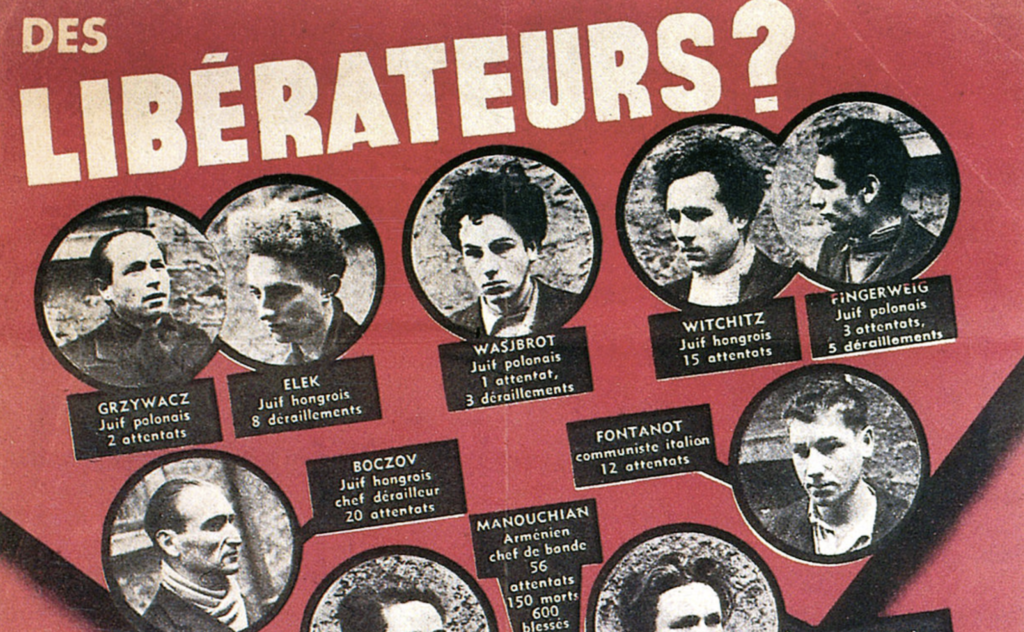By Adrien Welsh (translated from the French by Bronwyn Cragg)
Cet article est également disponible en français
February 21, 1944, Mont Valérien, 3pm. Nazi rifles detonate and shoot down 23 resistance fighters, half of whom are under the age of 25. All are part of the Manouchian group — Manouchian, leader of the Partisan Snipers of the Main-d’œuvre immigrée. All but two are foreigners, many are Eastern Europeans, many are Jewish, and others are Spanish Republicans in exile. All are communists.
The Organisation de la Main-d’œuvre immigrée (MOI) was founded in 1925, when the French Communist Party decided to organize foreign workers into language groups in order to integrate them into the country’s social and political battles. During the Spanish Civil War, many of them volunteered and served in the International Brigades: to struggle against fascism in Spain was to struggle against Nazism.
In 1942, the French Communist Party decides to intensify its resistance action, in particular armed resistance, and creates a military body: the Partisan Snipers (FTP – les Franc-tireurs partisans). The Main-d’œuvre immigrée joins the movement and creates its own detachment, the FTP-MOI. With the “old” seasoned in the fight in Spain or in the clandestine struggle in other countries, young immigrants in the prime of their life are gathered, sometimes very young (some not yet fifteen), all gathered by the desire desire to fight against the Nazi occupier and to fight against fascism.
From the moment of their creation, the FTP-MOI were the authors of remarkable feats of arms in occupied Paris, including assassinations of high-ranking Nazi officials, derailments of trains, the bombing of strategic occupation-administration buildings, etc. The attacks followed one another at a consistent and sustained pace: it is estimated that, on average, the hundred or so resistance fighters were behind one attack every two days.
This score is all the more remarkable as, from 1942, the German army knew it was at its peak. That people in the heart of Paris would dare to attack it seemed unthinkable. So, the battle was as much a military feat as it was a psychological one: the idea was to make life in Paris unbearable to the occupying troops. The actions of the FTP-MOI were all the more crucial as, since the summer of 1943, each of the other resistance groups in Paris had fallen into the hands of the police, who had hunted them down under the banner of the occupier, or had otherwise been dissolved by defeatism.
In the autumn of 1943, the principal elements of the group are arrested. Their highly-publicized trial allows the Nazis and the Vichyists to deal a great blow upon the resistance movement through their propaganda. This trial is quite timely: between 1942 and the end of 1943, the omnipotence of the German army seems to have ended, the Nazi regime being bogged down on the Eastern front with the bitter defeat at Stalingrad. However, this trial makes it possible to attack the Resistance and to present their fighters as foreigners and Jews on Moscow’s payroll.
No surprise, the 23 accused are sentenced to death. The day after their execution, the day that “the rifles bloomed”, the walls of Paris are lined with red posters upon which the portraits of the freedom fighters are printed, with the inscription, “Liberators? Liberation by the Army of Crime”. We see 11 of the 23 shot, shaggy and threatening, their foreign origins and their actions highlighted. The desired effect is to provoke an aversion among the French towards the Maquisards and the Resistance.
As we celebrate the 75th anniversary of the victory of the peoples over Nazism and Fascism, we must first remember that, without resistance fighters like Manouchian, Bancic, Alfonso and thousands of others, liberation would never have been possible. As communists, they never shuddered before death and never wavered before the imperatives of the struggle.
We must remember, when a monument to the glory of the Victims of Communism is built in Ottawa, and when the European Parliament adopts a motion putting communism and fascism on an equal footing, it is in fact the Communists who were often the only ones to maintain organization and to deliver heroic resistance from within. They did so even when De Gaulle initially called for resistance from the outside, relying even on British and American imperialism, but also on the French colonial empire.
Finally, to remember the history of these “twenty-three foreigners, but our brothers nevertheless” is to emphasize, during times when we hear more and more hate speech insinuating that the cultures of certain immigrants are incompatible with our values, the contribution of immigrants in the struggle for the liberation of their adopted homeland. These heroic actions contrast with those of the “good Frenchmen” who did not hesitate for a second to collaborate with the Nazis. No doubt even today, if a similar opportunity arose, the Marine Le Pens, Boris Johnsons, or even Maxime Berniers of this world would be the first to collaborate.
You may also like
-
Bangladeshi student uprising: From grassroots to technocracy in a flash
-
Cuban and Canadian youth celebrate UJC & OPJM anniversary
-
From Edmonton to Sudan, down with Canadian imperialism
-
YCL-LJC and UJC of Cuba hold productive bilateral meeting
-
Panama police attacks youth and student activists / La police panaméenne attaque les militants de la jeunesse et des étudiants


1 thought on “Death Does Not Dazzle the Eyes of the Partisans”
Comments are closed.